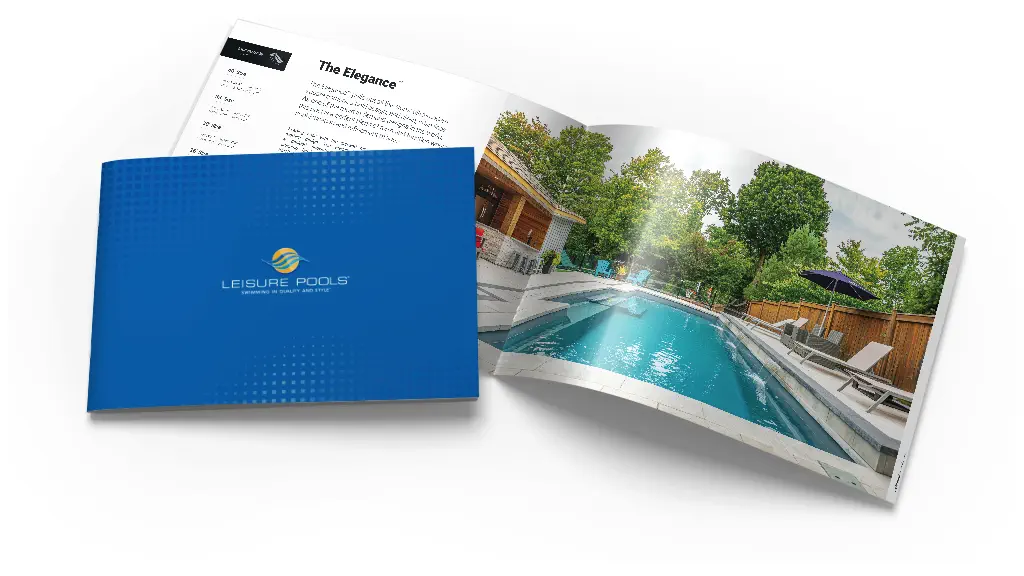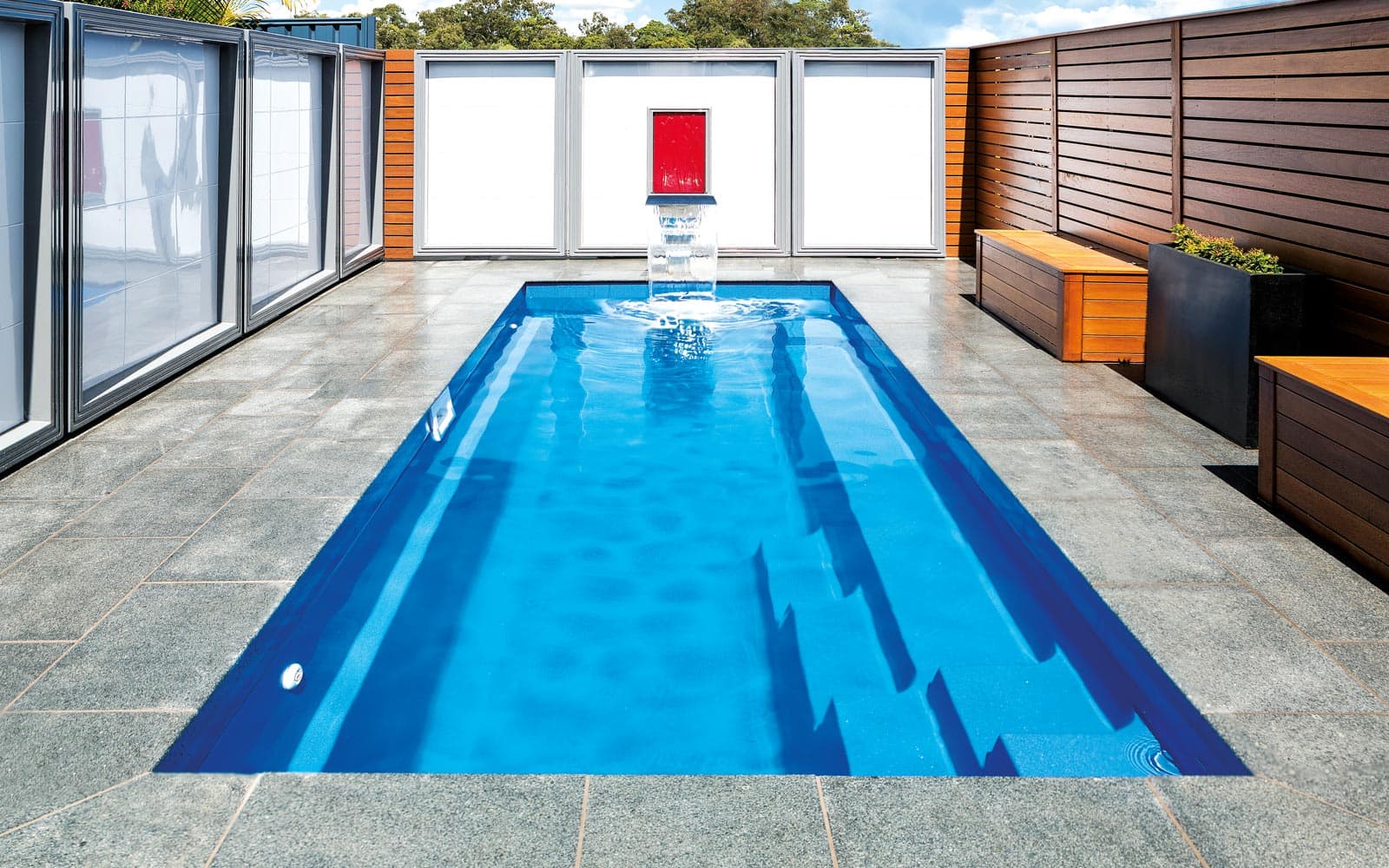
Swimming Pool Maintenance 101: Maintaining The Perfect Water Chemistry

Maintaining your swimming pool’s water isn’t hard. It’s all about balance. The key to crystal-clear sparkling water is to stay on top of it by maintaining the perfect water chemistry.
Your swimming pool’s water is always changing all season long. Your water needs at opening or closing your pool are quite different than in the heat of the summer. Everything that comes in contact with your swimming pool’s water will affect it – swimmers, weather, even lawn treatments and pesticides outside the pool will affect the water.
Before we begin our chemistry lesson on maintaining healthy, balanced swimming pool water, let’s cover how and why fiberglass pools are the easiest to maintain.
Swimming Pool Maintenance by Type
There are three types of inground swimming pools – fiberglass, vinyl liner and concrete. Each swimming pool type offers features and benefits that can suit your desired look, feel and budget. However, for our purposes, we’ll focus on how each type stacks up when it comes to balancing your pool’s water.
When it comes to swimming pool maintenance, fiberglass or composite pools come out on top. Why? Their nonporous finishes are virtually impenetrable.
Fiberglass Pools Have The Lowest Short-term maintenance costs:
Fiberglass pools’ smooth, nonporous surfaces make water chemistry more manageable and less costly to maintain. Their finishes also inhibit algae growth. When paired with a salt chlorinator, pool owners will find their maintenance time is further reduced, and their swimming experience is superior with silky-soft water.
Fiberglass Pools have the Lowest Long-term Maintenance Costs:
Some fiberglass pool manufacturers offer a lifetime guarantee on their pool’s color and finish, unlike vinyl and concrete pool alternatives.
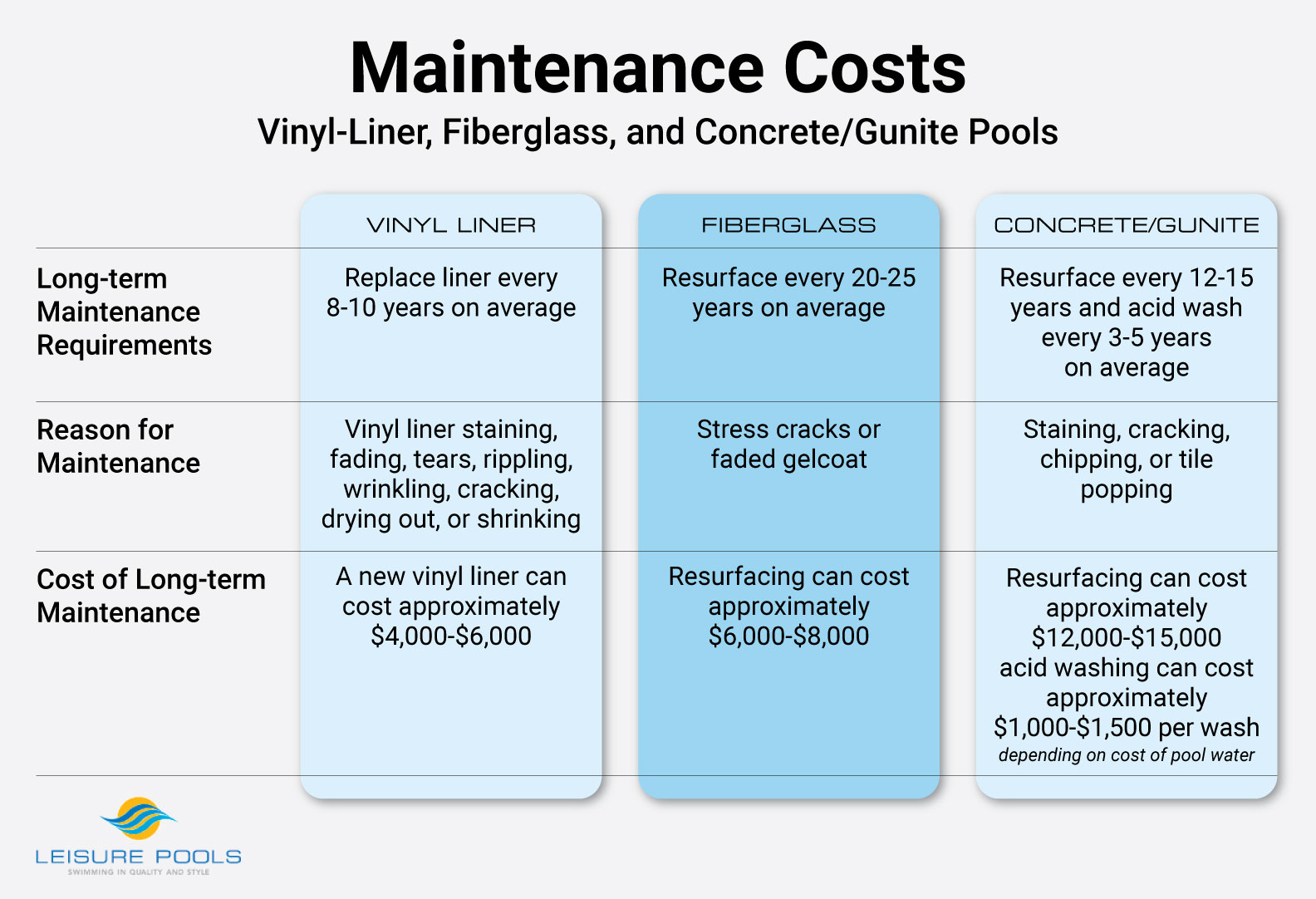
Additional Long-term Maintenance Costs:
Every time a pool is drained for maintenance, there are substantial costs associated with new water. High additional costs with resurfacing and vinyl liner replacement include new water, chemicals to treat the new water and energy costs to filter, and in some cases, heat the new water.
Above and beyond the investment protection of a fiberglass swimming pool’s lifetime guarantee, fiberglass swimming pools are lauded for their dramatically lower water chemistry maintenance. Due to their nonporous nature, the fiberglass swimming pool’s water is less susceptible to fluctuation due to the elements, bather load and gas emissions associated only with concrete or Gunite pools.
For more information on inground swimming pool types, pros and cons and more, check out our Swimming Pool Buyer’s Guide.
Maintaining Swimming Pool Water Chemistry
Regardless of how and when you’re enjoying your swimming pool, one fact remains, test your water regularly. How often depends on several significant factors.
How often to test your water depends on these factors:
- Frequency of swimming pool use
- How many people and pets use your swimming pool
- Changing weather – rain, high winds, extreme heat or cold
- Recent fertilization or pest treatment on or near your property
Rule of thumb:
During the height of the season, and heavy use, test chlorine and pH levels two to three times a week. Also, following rain showers, heavy usage, pets swim, or you fertilize your lawn and plants, you will need to test Total Alkalinity, Total Dissolved Solids (TDS), and Calcium Hardness. We recommend those tests at least once a month.
Chemistry basics: balancing swimming pool and spa water
In this section, we’ll dive into the detail of what healthy balanced water means. We’ll look at not just the beauty of clean and clear swimming pool water, but the chemistry makeup of the water. We’ll also explore what truly balanced water means, how to achieve balance, and how to maintain it. And finally we’ll give you tricks and tips on how to get your pool’s water back in balance.
Proper swimming pool water filtration and sanitization are essential for swimmer comfort and safety. However, out of balance swimming pool water can cause more issues than red eyes and dry skin; it can damage your equipment and surfaces if scale or corrosion occurs. Properly balanced swimming pool water will prevent metal corrosion as well as pool surface scaling.
Top Five factors of balanced water:
- pH
- Total Alkalinity
- Calcium Hardness
- Temperature
- TDS (Total Dissolved Solids).
We will cover all of these factors and how they relate to one another in detail in subsequent articles. Here, we’ll cover all the critical levels of water balance.
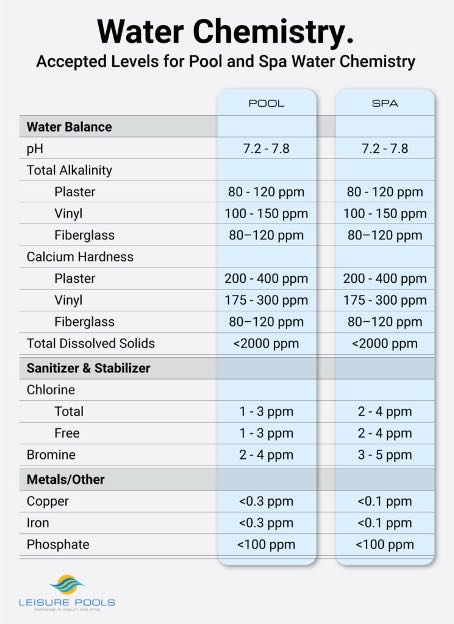
Top 10 Reasons Pool Water Turns Cloudy
- Not enough Chorine
- Algae – live or dead
- Undersized pool filter
- Dirty pool or pool filter, and strainer baskets are full
- Insufficient pump usage
- Water is out of balance
- Excessive rain
- A large bather load
- Over or under treating chemical treatment of pool water
- Heavy pollen, use of pesticides or fertilizers around the pool
Chemistry Lesson:
Test your swimming pool water often, and treat only as needed. Believe it or not, you can cause more harm than good when over-treating your swimming pool’s water.
Cloudy water most often occurs due to inconsistent water chemistry management. The root cause is typically low chlorine levels. Testing and maintaining your pool’s water should only take minutes when you’re vigilant. In contrast, it takes a lot of time and money to bring your water back into balance.
Keep It Clean
Regularly vacuum, skim, and brush all swimming pool surfaces. Doing so will prevent debris from breaking down and lessen the likelihood algae will form.
Your filtration system will perform better when you regularly clean your filter and skimmer baskets. Backwashing is required with sand and Diatomaceous Earth (D.E.) pool filters, which will keep them running more efficiently. With backwashing comes water and chemical loss. Always test your swimming pool’s water after replenishing it.
Chemicals
Remember, less is more. Yes, test your swimming pool water regularly, but only add chemicals as needed. Consistently testing and treating your swimming pool’s water, as needed, will keep it in balance. Irregularly chlorinating your swimming pool’s water will cause unhealthy chemical highs and lows, waste money and cause problems. The fewer chemicals introduced to your water, the easier it will be to keep your swimming pool’s water balanced. Every time you add chemicals that your water doesn’t need, you run the risk of potential chemistry, clarity, and safety problems. It bears repeating; less is more — Less cost and time spent maintaining your swimming pool.
Equipment
When it comes to selecting, installing, or replacing pool and spa equipment, always enlist a pool professional’s help. They will have a better understanding of how your geography can affect your swimming pool in terms of weather and debris types found in your water. They will also consider your needs to understand better what you need from your equipment – plumbing size and gallons of water and how your current equipment works, or doesn’t work. Over and undersized pool equipment can be ineffective, and worse, lessen its life. Oversized equipment can also waste energy and money.
Professional Tip
Periodically get your water professionally tested. The pros will assess your swimming pool water’s needs and can help you keep your water in balance.
All About Chlorine:
Your swimming pool’s water has two forms of Chlorine – Free Chlorine and Combined Chlorine.
Free Chlorine (good Chlorine)
is the chlorine you add to your water to kill bacteria and viruses. Free Chlorine should always be maintained between 1-3 Parts per Million (PPM).
Combined Chlorine (bad Chlorine)
occurs when Free Chlorine combines with pool and spa water contaminants. Contaminants such as grooming products, bacteria and body oils can turn good into bad chlorine quickly. Combined Chlorine, also known as Chloramines, is precisely the chlorine that irritates eyes and skin and gives off a strong odor. Keep Combined Chlorine between 1 and 3 PPM for effective and more comfortable sanitization.
How to destroy Combined Chlorine
Always test for Total Chlorine, not just Free Chlorine. Total Chlorine = Free + Combined Chlorine
To kill Combined Chlorine, you must shock your pool’s water. Doing so will raise your Free Chlorine level. But, do it precisely, with an accurate reading. When you test for Total and Free Chlorine, you can calculate the amount of Combined Chlorine by subtracting the Free Chlorine from the Total Chlorine. Combined Chlorine = Total Chlorine – Free Chlorine
All About pH:
For swimming pool water to be in balance, pH, Alkalinity, calcium hardness and Total Dissolved Solids (TDS) must be maintained in their proper range. The ranges can vary slightly, depending on the average temperature of your pool’s water and the type or finish of your pool.
The most critical factor in balancing swimming pool water is pH. The acceptable range of pH is from 0 to 14. When balancing your pool’s water, you should strive for 7. The mid-range of 7 is ideal because it’s neutral; 0 is the most acidic and 14 is the most alkaline. However, for pool water to be genuinely balanced, pH can fall within the narrow window between 7.2 and 7.8. The key to keeping your pH in check is to keep your swimming pool clean and clear of debris and algae. When materials breakdown or dissolve in your swimming pool’s water, they throw your pH into unacceptably high or low ranges.
High pH lessens chlorine’s effectiveness, water becomes alkaline, and is the perfect environment for mineral deposits (scale) to form.
Low pH makes water corrosive and can damage finishes and equipment.
The secret to controlling pH is to maintain alkalinity first. Keeping alkalinity within 80-120 PPM range makes balancing pH easier.
All About Alkalinity:
The best way to control pH is by maintaining Alkalinity first. Alkalinity can prevent pH from rising, making your swimming pool water corrosive. When Alkalinity is within the acceptable range, 80 to 120 PPM, it prevents rapid pH changes and stabilizes the pH level.
Low Alkalinity
When Alkalinity is too low, your pool finish can become etched and stained, metals can corrode, water can turn green, swimmers’ eyes tend to burn, and pH can fluctuate.High Alkalinity
When Alkalinity is too high, pH is difficult to adjust, the water turns cloudy, the pool constantly needs acid, and the chlorine becomes ineffective.
Salt Chlorine Generation: A Better Way To Balance Swimming Pool Water In Fiberglass Pools.
Saltwater pools are powered by salt chlorinators, also known as salt chlorine generators, and they have become very popular for good reason. They deliver a luxurious swimming experience while reducing the time it takes pool owners to maintain their swimming pools.
All About Salt Chlorine Generators
It’s very simple: Salt Chlorine Generators turn salt into chlorine. It’s the chlorine, not pool salt, that will sanitize your swimming pool’s water. Your Salt Chlorine Generator uses electrolysis to create pure or good chlorine from a small amount of swimming pool salt. Then, once the chlorine sanitizes your pool’s water, the chlorine converts back to salt, and the process happens over and over.
How Salt Chlorinators Work
Salt Chlorinators are comprised of two components – the control box and salt cell. The control box is the brains of the operation while the salt cell does all the work. The salt cell received commands from the control box to make chlorine – when and for how long. Also, salt chlorinator cells can shock, or super chlorinate, your pool’s water.
The more technical name for salt cells is electrolytic converters. They’re plumbed into your swimming pool’s return line. The key is that the salt chlorine cell MUST be installed AFTER or BEHIND the other pool equipment. The salt cell should always be installed behind the pump, filter and heater.
When a swimming pool’s water enters a salt chlorinator’s salt cell, the control box generates a very safe electrical charge, which turns dissolved pool salt into Free Chlorine. The Free Chlorine is then distributed evenly, by the pool return jets, throughout the water. Once the Free Chlorine has chlorinated the swimming pool’s water, the control box tells the salt cell to convert the chlorine back to salt, and the process happens over and over forever. We say forever because the salt in a saltwater swimming pool doesn’t break down or evaporate. It only needs to be replaced when new water is introduced to the swimming pool due to splash out or backwashing.
Salt Chlorinator Potential Cons by Pool Type
Salt chlorinators are a great alternative over traditional chemical chlorine for the sanitization of swimming pool water. However, they’re not right for every swimming pool type. Let’s evaluate the different pool types and how they fare with salt chlorination.
Composite Fiberglass Pools
The swimming pool industry followed the boating industry to pursue the ultimate material that can stand up to salt. Because fiberglass isn’t porous, it’s the ideal material for swimming pools. Even with the addition of salt chlorination, they’re still impervious to salt and make algae hard to form.
Concrete Pools
Salt Chlorine Generators are not ideal for the rough and porous surfaces of concrete swimming pools. In concrete swimming pool applications, salt chlorinators are more abrasive than traditional chlorine. More frequent and costly resurfacing will consequently be needed on concrete swimming pools with salt chlorinators. Many pool owners are willing to take on these additional maintenance costs in exchange for the silky-soft water that only salt chlorinators can deliver.
Vinyl Liner Pools
Like with concrete swimming pools, some pool builders advise against salt chlorination on vinyl-liner pools. Also, like with concrete pool owners, some are willing to take on additional maintenance costs. Also, in vinyl-liner applications, salt chlorination can cause metal surfaces to rust.
Salt and Fiberglass Are A Perfect Match
Composite fiberglass swimming pools are designed and ideally suited for salt chlorination. While fiberglass swimming pools offer lower maintenance costs, salt chlorination further reduces time and money to keep your swimming pool water chlorinated. Like the silky-soft surface of a fiberglass pool, salt chlorination offers silky-soft water—what a perfect duo.
For more technical details on how salt chlorinators work, read our Definitive Guide to Salt Water Pools. In the guide, we cover the specific type and amount of salt used with Salt Chlorine Generators and the ins and outs of how they work.
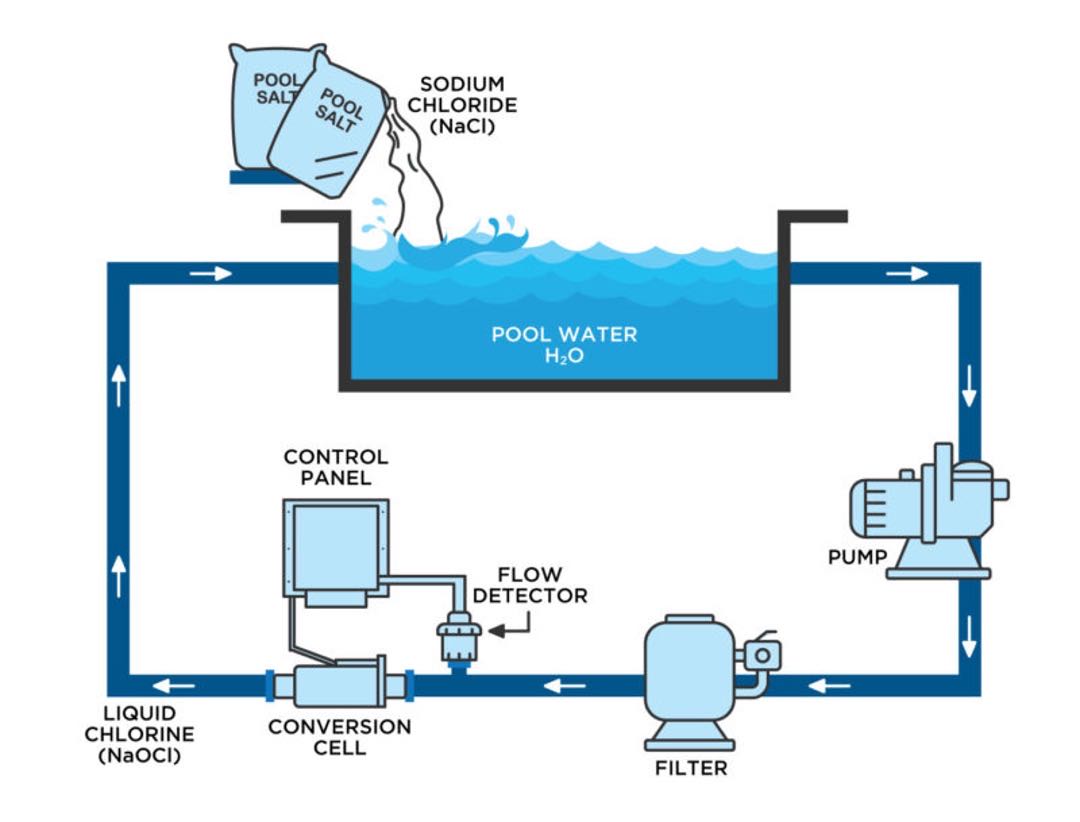
3 Simple Steps To Keeping Your Water Chemistry Balanced
Step 1 – Keep Your Water Free And Clear Of Debris
Step 2 – Skim And Filter The Water Regularly
Step 3 – Test Your Swimming Pool Water Regularly And ONLY Treat The Water With What It Needs, Nothing More
When you test your swimming pool water regularly to keep it in balance, it’s easy. It’s only when water chemistry levels get far out of acceptable range that it gets challenging and costly to maintain. From small to large lap pools, the chemistry levels and maintenance are the same. However, each day of the swimming pool season can bring new challenges. Weather, changing the treatment of surrounding landscape and even different chemicals used can alter your pool’s water. To the challenges you and your swimming pool’s water face, we stand firm. As long as you are vigilant in testing and treating your pool water, it’s easy as 1, 2, 3.
To learn more about Salt Chlorine Generators, check out our Definitive Guide to Salt Chlorination.


